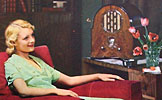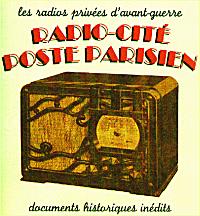THE PHILIPS GALLERY 
 Loudspeaker
type 2007 (1927) :
This electromagnetic loudspeaker sometimes nicknamed "shaving-plate" or "flying saucer" is a brilliant example of creative industrial design. The motor and its paper cone is inside the smaller bakelite bowl. The larger parabolic bowl is used as a reflector. A small rotating switch on the cord enables three different impedances : 500, 1500 and 200 ohms. This loudspeaker is found in three different sizes (large : 2007, medium : 2003, small : 2015) and various colours. The 2015 seems to have existed only in plain brown .The one shown here is marbled brown and red with gold (in fact brass powder) inclusions. The patterns are always different, as the colour ingredients were incorporated in a random way. So each instance is unique...
Loudspeaker
type 2007 (1927) :
This electromagnetic loudspeaker sometimes nicknamed "shaving-plate" or "flying saucer" is a brilliant example of creative industrial design. The motor and its paper cone is inside the smaller bakelite bowl. The larger parabolic bowl is used as a reflector. A small rotating switch on the cord enables three different impedances : 500, 1500 and 200 ohms. This loudspeaker is found in three different sizes (large : 2007, medium : 2003, small : 2015) and various colours. The 2015 seems to have existed only in plain brown .The one shown here is marbled brown and red with gold (in fact brass powder) inclusions. The patterns are always different, as the colour ingredients were incorporated in a random way. So each instance is unique...
 Model
2501(1928) :
The oldest Philips radio and one of their rare battery sets. The austere cabinet is metallic and covered with dark-blue pegamoïd ( something like imitation leather ). The robust mechanical and electronic construction make the radio very reliable. After 60 years spent in a cellar, this radio was still in working condition ! It is equipped with 4 valves and requires an external loudspeaker. Model 2514, similar at first sight, is much more common : it is the first mains operated Philips set.
The sound clip here is an advertisement for Philips Valves, an insurance against bad reception !
Model
2501(1928) :
The oldest Philips radio and one of their rare battery sets. The austere cabinet is metallic and covered with dark-blue pegamoïd ( something like imitation leather ). The robust mechanical and electronic construction make the radio very reliable. After 60 years spent in a cellar, this radio was still in working condition ! It is equipped with 4 valves and requires an external loudspeaker. Model 2514, similar at first sight, is much more common : it is the first mains operated Philips set.
The sound clip here is an advertisement for Philips Valves, an insurance against bad reception !Here is the special card (original size is 22 x 13,5 cm) which came with those early Philips sets, allowing the listener to take note of the many settings, allowing him to find his favourite stations again ! Here is the front and the back that you can print for writing your own settings if you possess a radio of that kind !
 Loudspeakers
types 2016 and 2026 (1928) :
Collectors have nicknamed them "Chinese hats" ! They can be hanged to the wall or laid on the table thanks to an articulated metal prop. This was the cheapest speaker of the Philips line. The moving-iron paper cone system gave satisfaction to most users, in spite of the somewhat narrow frequency response !
Loudspeakers
types 2016 and 2026 (1928) :
Collectors have nicknamed them "Chinese hats" ! They can be hanged to the wall or laid on the table thanks to an articulated metal prop. This was the cheapest speaker of the Philips line. The moving-iron paper cone system gave satisfaction to most users, in spite of the somewhat narrow frequency response ! Here is a nice advert of the time for the 2016 : the front and the text at the back boasting its qualities : General harmony of the shape and fidelity, no polarity, no adjustment, light weight, 4 possible positions !
And here is an equally nice advert for the 2026 .
 Model
2511 (1929) :
Quite a heavy set ( 20 Kilos without the loudspeaker )! But also a high-quality radio. The 2511 is entirely mains-powered, a major technical breakthrough.
The cabinet is in "vanherite" a beautiful synthetic material which does not deteriorate, specially made for Philips. The chassis is in two separate units and includes 5 valves and a lot of metal shielding. It is a TRF circuit with very simplified controls. One volume knob, one tuning knob and one band switch. The top lid gives access to the works and disconnects the mains automatically for security. The bakelite loudspeaker ( type 2115 ) is an electrodynamic permanent magnet type, both powerful and musical with a good medium and low frequency range. For the first time, people could hear the bass in jazz-bands !
Model
2511 (1929) :
Quite a heavy set ( 20 Kilos without the loudspeaker )! But also a high-quality radio. The 2511 is entirely mains-powered, a major technical breakthrough.
The cabinet is in "vanherite" a beautiful synthetic material which does not deteriorate, specially made for Philips. The chassis is in two separate units and includes 5 valves and a lot of metal shielding. It is a TRF circuit with very simplified controls. One volume knob, one tuning knob and one band switch. The top lid gives access to the works and disconnects the mains automatically for security. The bakelite loudspeaker ( type 2115 ) is an electrodynamic permanent magnet type, both powerful and musical with a good medium and low frequency range. For the first time, people could hear the bass in jazz-bands ! Model
930A (1933) :
This celebrated "gothic" radio is often called "Ham box" . The cabinet is not wood, but "arbolite", another specific Philips-made material. It does look like Brazilian rose-wood but has a brighter surface. The 930 A was a relatively cheap four-valve radio with a regenerative detector circuit. You had to turn up the reaction knob until the radio started to squeal, then turn it down slowly to get maximum sensitivity. The built-in loudspeaker was similar to the above-mentioned Chinese hats. The tiny dial had only a scale with numbers. But in those days there were few broadcasters and it was not difficult to tune them in !
Model
930A (1933) :
This celebrated "gothic" radio is often called "Ham box" . The cabinet is not wood, but "arbolite", another specific Philips-made material. It does look like Brazilian rose-wood but has a brighter surface. The 930 A was a relatively cheap four-valve radio with a regenerative detector circuit. You had to turn up the reaction knob until the radio started to squeal, then turn it down slowly to get maximum sensitivity. The built-in loudspeaker was similar to the above-mentioned Chinese hats. The tiny dial had only a scale with numbers. But in those days there were few broadcasters and it was not difficult to tune them in ! 
 Model
830A (1933) :
Super-Inductance ( Superior TRF ! ) circuit with 5 valves. The 830 A is a better receiver than the 930 A. The cabinet is also arbolite and the shape is more elegant with the delicate vegetal loudspeaker grille The "lion's feet" are also to be noted. The set is perfectly symmetrical with two knobs only. In fact the right knob is turned for tuning and pulled/pushed for LW/MW selection. This idea of multi-purpose knobs was to culminate in 1936 with a series of "single knob" sets : Only one large knob that you had to turn, push or twist in all directions...and a nightmare for servicemen !
Model
830A (1933) :
Super-Inductance ( Superior TRF ! ) circuit with 5 valves. The 830 A is a better receiver than the 930 A. The cabinet is also arbolite and the shape is more elegant with the delicate vegetal loudspeaker grille The "lion's feet" are also to be noted. The set is perfectly symmetrical with two knobs only. In fact the right knob is turned for tuning and pulled/pushed for LW/MW selection. This idea of multi-purpose knobs was to culminate in 1936 with a series of "single knob" sets : Only one large knob that you had to turn, push or twist in all directions...and a nightmare for servicemen !You can listen to a few commercials of the thirties sung by Charles Trénet and Johnny Hess : Thé des Familles, Lévitan and Brunswick.
 Model
636A (1933) :
Super Inductance with 8 valves ! A high-end radio for high-end listeners. French-polished walnut cabinet. Radios with such a rounded shape are known as "cathedral radios". But the 636 A is not a superheterodyne like most American cathedrals. It is a very sophisticated TRF circuit including anti-fading and silent tuning ( a kind of squelch ) The loudspeaker is a large electrodynamic type with a good frequency response enhanced by the closed wood cabinet. Mellow medium and deep bass...
Model
636A (1933) :
Super Inductance with 8 valves ! A high-end radio for high-end listeners. French-polished walnut cabinet. Radios with such a rounded shape are known as "cathedral radios". But the 636 A is not a superheterodyne like most American cathedrals. It is a very sophisticated TRF circuit including anti-fading and silent tuning ( a kind of squelch ) The loudspeaker is a large electrodynamic type with a good frequency response enhanced by the closed wood cabinet. Mellow medium and deep bass...Other Philips radios and accessories :
Detail of the logo in the shape of the 4210 microphone.
 Philips advertising :
Philips advertising :
 And now a few commercials....
With the advent of the private stations Poste Parisien (1932) and Radio Cité (1935) advertising became an ever-increasing part of broadcasting. The style certainly sounds obsolete and makes us smile, but in those days advertising on the radio was something quite revolutionary ! Listen to an extract of the remarkable 3 CD-set devoted to the archives of pre-war private broadcasters. These rare documents have been recorded on floppy 78 rpm discs before tape-recorders appeared in studios, and they are the first ever recorded radio programs.
(© Editions EPM musique 1994)
And now a few commercials....
With the advent of the private stations Poste Parisien (1932) and Radio Cité (1935) advertising became an ever-increasing part of broadcasting. The style certainly sounds obsolete and makes us smile, but in those days advertising on the radio was something quite revolutionary ! Listen to an extract of the remarkable 3 CD-set devoted to the archives of pre-war private broadcasters. These rare documents have been recorded on floppy 78 rpm discs before tape-recorders appeared in studios, and they are the first ever recorded radio programs.
(© Editions EPM musique 1994)
And as a conclusion, here is an hilarious sketch by Bach & Laverne (Odeon # 238.188 around 1935) entitled "Les gaietés de la radio"
 in which the announcers or Paris and Toulouse interfere with each other in a surrealistic dialogue...
in which the announcers or Paris and Toulouse interfere with each other in a surrealistic dialogue...